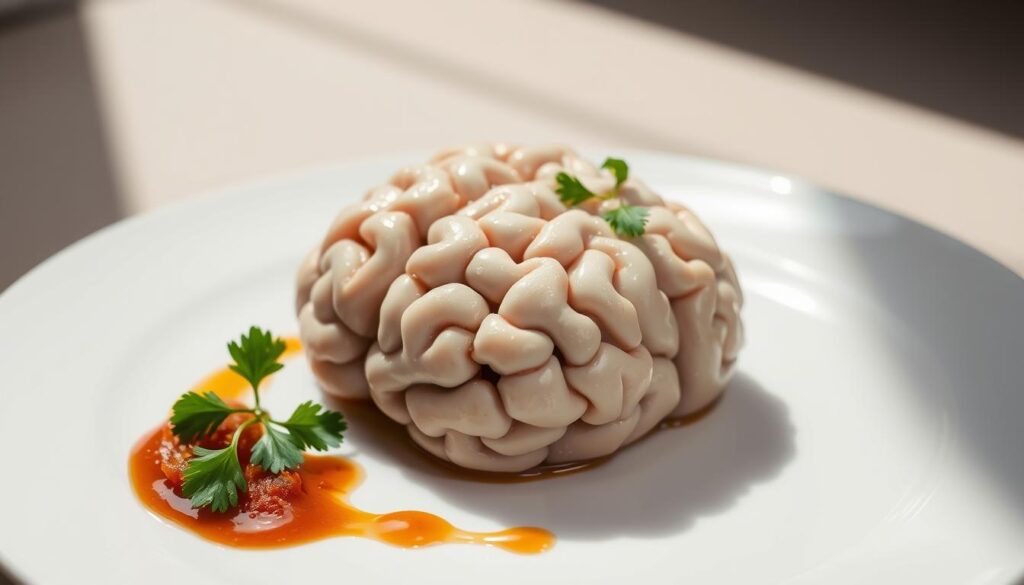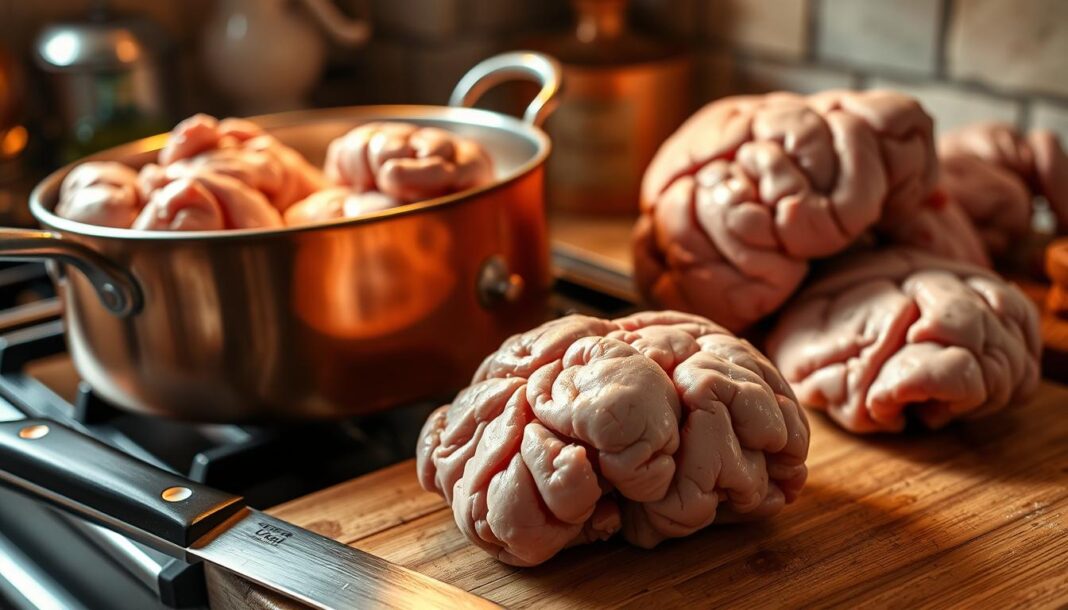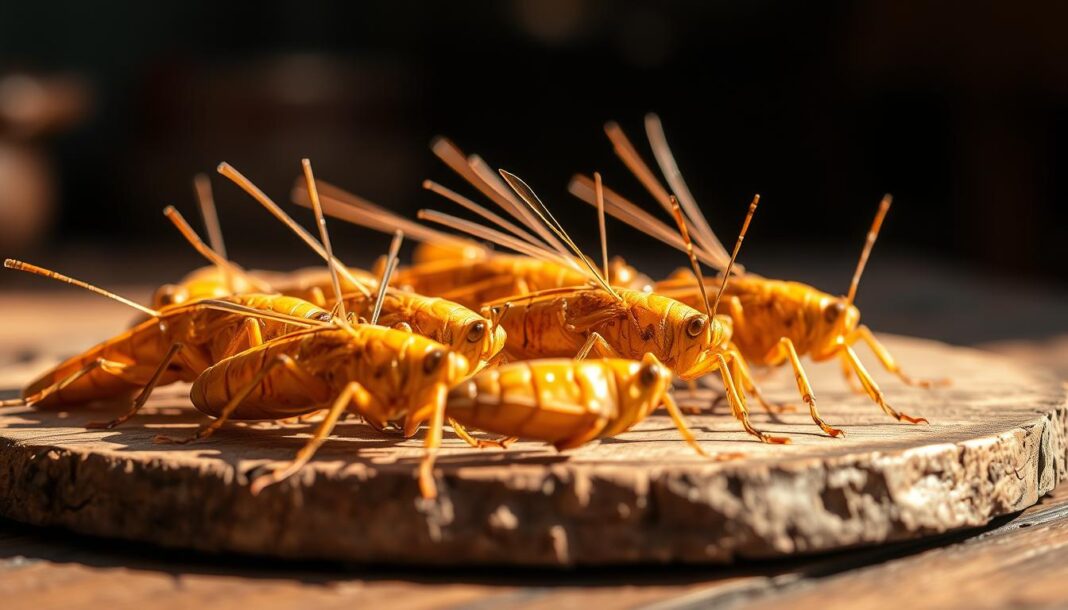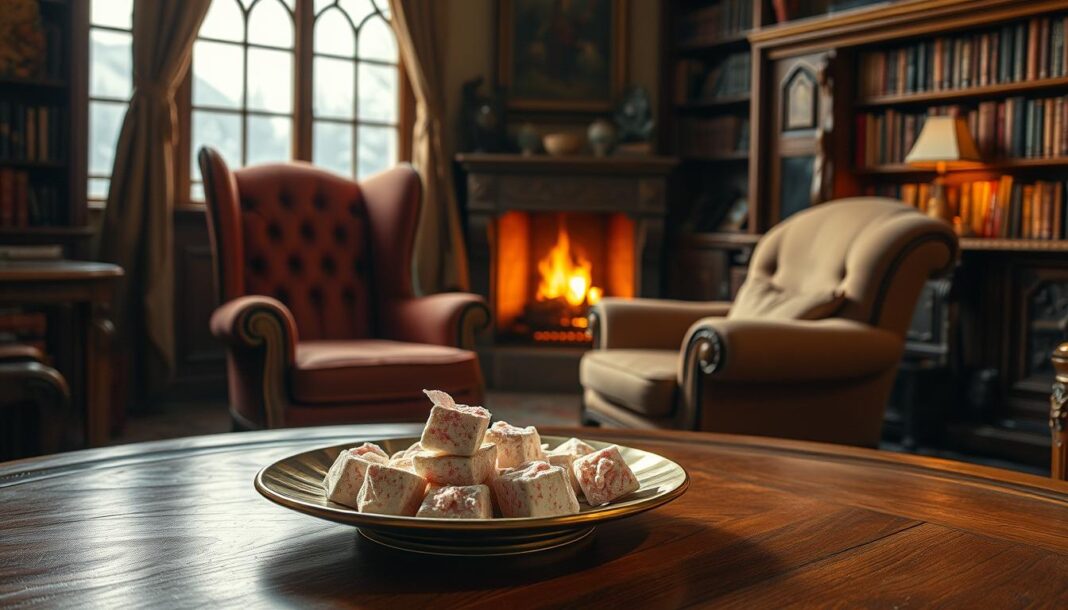Cooking calf brains is an art that has been refined over centuries, with this delicacy being valued for its unique texture and nutritional properties. We explore the historical context of preparing brains as a dish, a practice that transcends cultures and time periods.
As we delve into the world of cooking brain as a culinary meat, it becomes clear that the preparation of this organ meat has been a significant part of various cuisines, including great british traditions. The selection of quality ingredients is crucial, and mastering traditional preparation techniques is key to creating a memorable dish.
By understanding the scientific aspects of brain composition and its high fat content, we can appreciate why it’s a prized ingredient among chefs. This historical perspective shows how calf brains evolved from a necessity-based food source to a gourmet ingredient.
Key Takeaways
- Understanding the historical significance of cooking calf brains across different cultures.
- Learning about the nutritional properties and unique texture of brains.
- Exploring traditional preparation techniques for this delicacy.
- Appreciating the scientific aspects of brain composition.
- Discovering how to select quality ingredients for cooking brains.
The Cultural Significance of Calf Brains Throughout History
Throughout history, the preparation and consumption of calf brains have evolved, influenced by regional traditions and cultural practices. The story of how calf brains transitioned from being a simple ingredient to a celebrated delicacy in various cuisines is a testament to the dynamic nature of food culture.

From Necessity to Delicacy: The Evolution of Brain Consumption
The consumption of brains and other organ meats was initially driven by necessity, as they provided a valuable source of nutrition. Over time, different cultures began to appreciate these ingredients for their unique flavors and textures, elevating them to delicacies in certain culinary traditions. For instance, in French cuisine, cervelle (brain) dishes became renowned for their sophistication, such as cervelles au beurre noir, a dish that highlights the rich flavor of calf brains when cooked in black butter.
In many cultures, the preparation of calf brains was influenced by religious and cultural practices. For example, kosher butchering traditions, followed by communities like Meme Suissa’s, dictated the methods used to prepare brains for consumption. These practices not only reflected the resourcefulness of cooks but also the cultural significance attached to food preparation.
Regional Traditions and Cultural Perspectives
Regional attitudes towards brains as a food ingredient vary significantly. In Moroccan cuisine, for example, calf brains are prepared with saffron and lemon, creating a flavorful dish known as cervelle à la marocaine. This contrasts with Western preparations, where calf brains might be served with a creamy potato purée, as seen in the Galvin brothers’ signature dish at Bistrot de Luxe restaurant. These diverse approaches highlight the versatility of calf brains as an ingredient and their integration into various meat dishes.
The role of family traditions in preserving recipes for brain dishes is also noteworthy. Knowledge and techniques were often passed down through generations in home kitchens, before being documented in cookbooks. This transmission of culinary knowledge underscores the importance of food in cultural heritage and identity.
Understanding Calf Brains: Nutrition and Selection
In exploring calf brains, we’re not just examining a food item; we’re looking at a symbol of culinary ingenuity and sustainability. This delicacy has been cherished across various cultures, not just for its unique taste but also for its nutritional benefits and the values it represents in nose-to-tail cooking.
Nutritional Profile and Health Benefits
Calf brains are rich in nutrients, offering a dense source of protein, vitamins, and minerals. They are particularly known for their high content of brain-boosting compounds. According to a study on the nutritional benefits of organ meats, including brains, they provide essential nutrients that support cognitive function and overall health.
| Nutrient | Amount per 100g | Health Benefit |
|---|---|---|
| Protein | 10g | Muscle repair and growth |
| Iron | 2mg | Oxygen transport and energy |
| Vitamin B12 | 10mcg | Nervous system function |
How to Select and Source Quality Calf Brains
When selecting calf brains, it’s crucial to source them from reputable suppliers to ensure freshness and quality. Look for brains that are firm, with a creamy color and a fresh, meaty smell. Sourcing from local farms or butchers who practice ethical farming can enhance the quality of the meat.
Ethical Considerations in Nose-to-Tail Cooking
The practice of using calf brains and other organ meats is deeply rooted in the philosophy of nose-to-tail cooking, which aims to reduce waste and honor the animal’s sacrifice. This approach not only supports sustainable food systems but also fosters a deeper connection between consumers and their food sources. By embracing this culinary tradition, we promote a more mindful and respectful relationship with the food we eat and the animals that provide it.
Essential Preparation Techniques for Calf Brains
The art of cooking calf brains involves several essential preparation techniques that enhance their delicate flavor and texture. Whether you’re a seasoned chef or an adventurous home cook, understanding these methods is crucial for creating memorable dishes.
Cleaning and Preparing Raw Calf Brains
Before cooking, calf brains require careful cleaning and preparation. This process begins with removing membranes and blood vessels, which can be delicate but is essential for achieving a tender final product.
Removing Membranes and Blood Vessels
To remove the membranes, gently peel them away from the brain lobes, taking care not to damage the underlying tissue. This step is crucial for ensuring the brains cook evenly and are pleasant to eat.
Soaking and Initial Cooking Methods
After cleaning, calf brains are typically soaked in cold water or a mixture of water and vinegar to remove any remaining impurities. Initial cooking methods often involve poaching or blanching to set the texture before further preparation.
Traditional Cooking Methods Across Cultures
Different cultures have developed unique ways of preparing calf brains, reflecting local flavors and culinary traditions. Let’s explore a few of these methods.
Moroccan-Style Preparation with Saffron and Lemon
In Moroccan cuisine, calf brains are often cooked with saffron and lemon, creating a dish that is both aromatic and flavorful. This method involves gently simmering the brain in a spiced broth, which infuses them with the characteristic warm, sunny flavors of the region.
French Classical Approaches to Calf Brains
French cuisine offers a more subdued approach, often featuring calf brains in dishes like Tête de Veau, where they are served as part of a boiled beef head. This classic preparation highlights the brain‘s delicate flavor against a backdrop of rich, meaty textures.
Modern Interpretations in Contemporary Cuisine
Contemporary chefs are reinventing calf brain dishes by incorporating modern cooking techniques and global flavors. For instance, serving brain lobes with a creamy potato purée, as seen in the Galvin brothers’ signature dish at Bistrot de Luxe, showcases the versatility of this ingredient. Some chefs also serve small pieces of brain as part of a larger tasting menu.
As we explore these techniques, it’s clear that the key to preparing exceptional calf brains lies in balancing tradition with innovation.
| Cooking Method | Description | Flavor Profile |
|---|---|---|
| Moroccan-Style | Saffron and lemon-infused broth | Aromatic, sunny, slightly spicy |
| French Classical | Boiled with beef head (Tête de Veau) | Delicate, rich, meaty |
| Modern Interpretation | Served with creamy potato purée | Creamy, subtle, refined |
Bringing Calf Brain Dishes to Your Table
Having journeyed through the history, nutritional value, and preparation techniques of calf brains, you’re now poised to bring this unique ingredient to your table. As we guide you through the final steps of incorporating calf brains into your culinary repertoire, we emphasize the importance of creativity and experimentation in the kitchen.
When preparing calf brain dishes, consider pairing them with complementary side dishes like seasonal vegetables or berries to create a harmonious balance of flavors. For instance, a simple pan-fried calf brain recipe using butter, lemon, and parsley can be elevated by serving it alongside a fresh salad or roasted vegetables.
For those new to cooking calf brains, we recommend starting with straightforward recipes like pan-fried brains with brown butter or a deep-fried calf brain fritter. As you gain confidence, you can explore more complex preparations, such as brain-enriched cream sauces or incorporating cooked brains into next-day dishes.
To achieve restaurant-quality results in your home kitchen, maintaining proper heat control is crucial. Whether you’re cooking in a pan with oil or butter, or deep-frying, the key is to cook the brains at the right temperature to achieve the desired texture.
As you explore the world of calf brain cuisine, don’t be afraid to experiment and adjust recipes to your taste. With practice and patience, you’ll master the art of preparing this unique ingredient, and it will become a valuable addition to your culinary repertoire.


